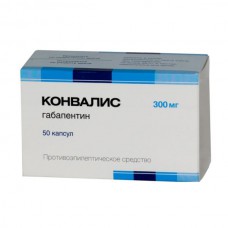Expiration date: 07/2028
Structure and Composition:
The capsules. One capsule contains Gabapentin 300 mg
Excipients: lactose monohydrate, corn starch, talc magnesium stearate, pregelatinised
hard gelatin capsule shell: titanium dioxide, yellow oxide of iron gelatin
in strip cellular pack 10 pcs. 3 a stack of cardboard packages or 5.
Description pharmaceutical form:
Capsules yellow.
The contents of capsules - amorphous or crystalline powder white or white with a slightly yellowish tint.
Pharmacokinetics:
Bioavailability is not proportional to the dose of gabapentin - by increasing the dose is reduced. After oral administration, Cmax of gabapentin in plasma achieved in 2-3 hours. The absolute bioavailability of gabapentin capsules is approximately 60%. Foods including with a high content of fat, it has no effect on pharmacokinetics. T1 / 2 of the plasma is independent of dose and averages 5-7 hours. Pharmacokinetics unchanged with repeated use of the equilibrium concentration in the plasma can be predicted on the basis of the results of a single dose. Gabapentin is almost bound to plasma proteins (less than 3%) and has a volume of distribution equal to 57.7 liters.
Is not metabolized, it does not induce hepatic oxidative enzymes mixed function involved in the metabolism of drugs. Excreted by the kidneys unchanged. Clearance from plasma gabapentin reduced in the elderly and patients with impaired renal function. The constant rate of excretion, clearance from the plasma and renal clearance are directly proportional to creatinine clearance. Gabapentin is removed from plasma by hemodialysis. Patients with impaired renal function and patients on hemodialysis, dose adjustment is recommended (see. "Dosage and administration").
Description of the pharmacological actions:
Gabapentin is structurally similar to the neurotransmitter GABA but its mechanism of action differs from that of some other drugs affecting GABAergic transmission including valproate, barbiturates, benzodiazepines, inhibitors of GABA-transaminase reuptake inhibitors GABA agonists, GABA receptor and prodrugs of GABA he GABAergic has no properties and no effect on GABA capture and metabolism. Preliminary studies suggest that gabapentin is associated with & alpha2- & delta-subunit voltazhzavisimyh calcium channels and inhibits the flow of calcium ions, which plays an important role in the onset of neuropathic pain. Other mechanisms involved in the action of gabapentin for neuropathic pain are: glutamatzavisimoy decrease neuronal death, increasing GABA synthesis, inhibition of monoamine neurotransmitter release group. Gabapentin at clinically relevant concentrations, does not bind to receptors of other drugs or neurotransmitters, including GABA receptors, GABA B, benzodiazepine, glutamate, glycine receptors, and N-methyl-d-aspartate. Unlike phenytoin and carbamazepine, gabapentin does not interact with sodium channels in vitro. Partially attenuates the effects of glutamate receptors agonist N-methyl-d-aspartate in some tests in vitro, but only at a concentration of 100 micromoles, which is not achieved in vivo. Several reduces emissions of monoamine neurotransmitters in vitro.
Indications:
- epilepsy (in adults and children over 12 years - as a monotherapy or in combination therapy for the treatment of partial seizures, including proceeding with secondary generalization)
- treatment of neuropathic pain in adults.
Contraindications:
- Hypersensitivity to the various components of the drug
- acute pancreatitis
- children's age (12 years).
Precautions: renal impairment (see "Dosage and Administration".).
Application of pregnancy and breastfeeding:
There are no data on the use of the drug in pregnant women, so Konvalis should be used during pregnancy only if the expected benefit to the mother justifies the potential risk to the fetus.
The drug is excreted in breast milk, its impact on the breastfed child is unknown, so during treatment should abandon breastfeeding.
Side effect:
In the treatment of neuropathic pain
From the digestive tract: constipation, diarrhea, dry mouth, dyspepsia, flatulence, nausea, vomiting, abdominal pain.
From the nervous system: gait disturbance, amnesia, ataxia, confusion, dizziness, hypesthesia, somnolence, abnormal thinking, tremor.
The respiratory system: dyspnea, pharyngitis.
For the skin: skin rash.
From the senses: amblyopia.
Other: asthenic syndrome, flu-like symptoms, headache, infections, pain of various localization, peripheral edema, weight gain.
In the treatment of partial seizures
Cardio-vascular system: vasodilation symptoms, hypertension or low blood pressure.
From the digestive tract: flatulence, anorexia, gingivitis, abdominal pain, constipation, dental disease, diarrhea, dyspepsia, increased appetite, dry mouth or throat, nausea, vomiting.
From the blood system, the lymphatic system: purpura (often in the form of bruises that occur during physical injury), leukopenia.
From the musculoskeletal system: arthralgia, back pain, increased fragility of bones, myalgia.
From the nervous system: dizziness, hyperkinesia strengthening, weakening or absence of tendon reflexes, paresthesia, anxiety, hostility, amnesia, ataxia, confusion, incoordination, depression, dysarthria, emotional lability, insomnia, nystagmus, drowsiness, abnormal thinking, tremor fibrillation muscles.
The respiratory system: pneumonia, cough, pharyngitis, rhinitis.
For the skin: acne, skin itching, skin rash.
With the genitourinary system: urinary tract infection, impotence.
From the senses: blurred vision, amblyopia, diplopia.
Other: asthenic syndrome, face edema, fatigue, fever, headache, viral infection, peripheral edema, weight gain.
When comparing the tolerability of the drug in doses of 300 and 3600 mg / day dose dependency observed phenomena such as dizziness, ataxia, drowsiness, paresthesia, and nystagmus.
Drug Interactions:
When co-administered gabapentin and morphine when morphine was taken 2 hours prior to gabapentin, an increase "concentration-time" area average value under the curve (AUC) of gabapentin by 44% compared to a monotherapy gabapentin, which was associated with an increase in pain threshold ( Kholodov pressor test). The clinical significance of this change is not established, the pharmacokinetic characteristics of morphine is not changed.
Side effects of morphine during coadministration with gabapentin did not differ from those in the reception of morphine with placebo.
The interaction between gabapentin and phenobarbital, phenytoin, valproic acid, carbamazepine were found. The pharmacokinetics of gabapentin in the equilibrium state is the same in healthy subjects and patients receiving other anticonvulsants.
Concomitant use of gabapentin with oral contraceptives containing noretidron and / or ethinyl estradiol, was not accompanied by changes in the pharmacokinetics of the two components.
Antacids containing aluminum or magnesium, gabapentin reduced bioavailability by approximately 20%. In connection with this drug should be taken no earlier than 2 hours after taking antacids.
Cimetidine significantly reduces renal excretion of gabapentin.
Alcohol and agents acting on the central nervous system, may increase the side effects of gabapentin on the part of the central nervous system.
Dosage and administration:
inside
Epilepsy (monotherapy or combined therapy in adults and children older than 12 years). Treatment started with a dose of 300 mg 1 time per day and gradually increased to 900 mg / day (one day - 300 mg 1 time per day, in 2 minutes - 300 mg 2 times a day, in the 3rd - 300 mg three times a day). Subsequently, the dose may be increased. Usually Konvalisa dose is 900-1200 mg / day, the maximum dose - 3600 mg / day (equal to 3 receiving over 8 hours).
Neuropathic pain in adults. Treatment started with a dose of 300 mg 1 time per day and gradually increased to 900 mg / day (one day - 300 mg 1 time per day, in 2 minutes - 300 mg 2 times a day, in the 3rd - 300 mg three times a day). In the presence of intense pain Konvalis can be assigned to the first of the day in a dose of 300 mg three times a day. Depending on the effect, the dose may be increased, but not more than 3600 mg / day.
Patients with impaired renal function daily dose of: at creatinine Cl 50-79 ml / min - 600-1800 mg of 30-49 ml / min - 300-900 mg of 15-29 ml / min - 300-600 mg at least 15 ml / min - 300 mg on alternate days or daily.
In patients on hemodialysis, the initial dose is 300 mg Konvalisa. Additional postgemodializnaya dose is 300 mg once every 4-hour hemodialysis session. In the days when dialysis is not performed, Konvalis not appointed.
Overdose:
Symptoms: dizziness, double vision, drowsiness, dysarthria, diarrhea.
Treatment: gastric lavage, the appointment of activated charcoal, symptomatic therapy, hemodialysis.
Precautionary measures:
In the analysis of urine for total protein using litmus possible false positive result. You must confirm the result using another method.
In patients with diabetes is sometimes necessary to change the dose of antidiabetic drugs.
If signs of acute pancreatitis, drug treatment should be discontinued.
Cancelling the drug or replace it with an alternative means should be gradual, at least for a week.
During the period of treatment should refrain from driving and transport activities potentially hazardous activities that require high concentration and psychomotor speed reactions.
Storage conditions:
The sealed package.


